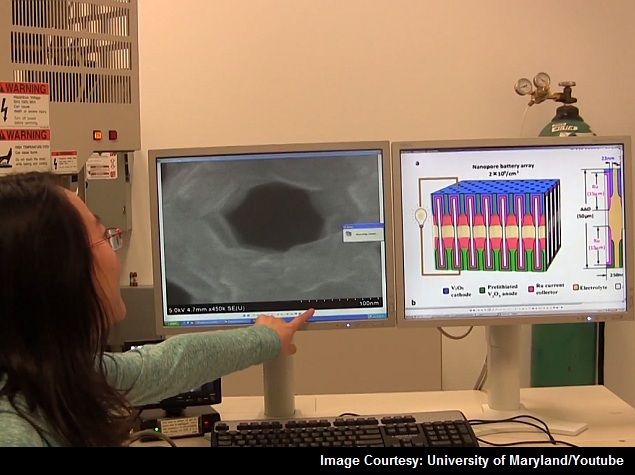- Home
- Science
- Science News
- Researchers Invent What May Be the Tiniest Battery in the World
Researchers Invent What May Be the Tiniest Battery in the World

Researchers in the US have invented a battery that is so small that many millions of them could be crammed into a space the size of a postage stamp.
The structure called nanopore was invented by researchers at the University of Maryland in the US and could result in the ultimate miniaturization of energy storage components, the researchers said.
A tiny hole in a ceramic sheet holds the electrolyte to carry the electrical charge between nanotube electrodes at either end.
Though still a test device, the microscopic battery performs well.
"It can be fully charged in 12 minutes and can be recharged thousands of times," said Chanyuan Liu, lead researcher from the University of Maryland.
(Also See: New Battery Said to Double Running Life of Smartphones, Laptops)
Researchers said they thought the reason the unit is so efficient is because each nanopore is shaped "just like the others", allowing them to pack the tiny thin batteries together closely. Eleanor Gillette, co-author, said the modelling shows the unique design of the nanopore battery is responsible for its success.
Gillette added that the space inside the holes is so small that the amount of space taken up when put together is still no more than a grain of sand.
Researchers believe this unit has great potential as its size allows packing of the tiny thin batteries together efficiently.
The scientists have identified improvements to make the next version of the battery 10 times more powerful.
Written with inputs from IANS.
For the latest tech news and reviews, follow Gadgets 360 on X, Facebook, WhatsApp, Threads and Google News. For the latest videos on gadgets and tech, subscribe to our YouTube channel. If you want to know everything about top influencers, follow our in-house Who'sThat360 on Instagram and YouTube.
Related Stories
- Amazon Great Indian Festival 2024
- Big Billion Days 2024
- Apple Vision Pro
- Oneplus 12
- iPhone 14
- Apple iPhone 15
- OnePlus Nord CE 3 Lite 5G
- iPhone 13
- Xiaomi 14 Pro
- Oppo Find N3
- Tecno Spark Go (2023)
- Realme V30
- Best Phones Under 25000
- Samsung Galaxy S24 Series
- Cryptocurrency
- iQoo 12
- Samsung Galaxy S24 Ultra
- Giottus
- Samsung Galaxy Z Flip 5
- Apple 'Scary Fast'
- Housefull 5
- GoPro Hero 12 Black Review
- Invincible Season 2
- JioGlass
- HD Ready TV
- Laptop Under 50000
- Smartwatch Under 10000
- Latest Mobile Phones
- Compare Phones
- Vivo Y18t
- Honor X9c
- Honor Magic 7 Pro
- Honor Magic 7
- Sharp Aquos R9 Pro
- Xiaomi 15
- Xiaomi 15 Pro
- Redmi A3 Pro
- Asus Zenbook S 14
- MacBook Pro 16-inch (M4 Max, 2024)
- Huawei MatePad 11.5
- Acer Iconia Tab 10.36 (iM10-22)
- Redmi Band 3
- Xiaomi Smart Band 9 Pro
- Sony 65 Inches Ultra HD (4K) LED Smart TV (KD-65X74L)
- TCL 55 Inches Ultra HD (4K) LED Smart TV (55C61B)
- Sony PlayStation 5 Pro
- Sony PlayStation 5 Slim Digital Edition
- Acer 1.5 Ton 5 Star Inverter Split AC (AR15AS5INGMA)
- Daikin 1.5 Ton 4 Star Inverter Split AC (FTKT50UV16V+RKT50UV16V)
















